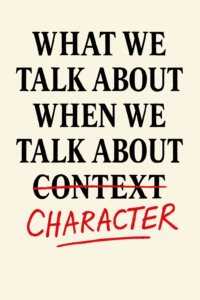A light thought experiment after reading Paul Dourish and Robert McKee in the same day.
This isn’t a rigorous theoretical argument—just something that clicked into place for me after spending the morning with Paul Dourish’s HCI research paper What We Talk About When We Talk About Context and the afternoon with Robert McKee’s narrative theory book Character. I wasn’t planning to compare them, but the overlap was too clean to ignore — and I was too proud of my Notes app witticism while reading the latter: What We Talk About When We Talk About Character.

Both works challenge flattened, overly rigid definitions—Dourish in HCI, McKee in narrative—and both push toward something more dynamic, relational, and enacted.
McKee argues that character isn’t a list of traits—it’s revealed through action under pressure. What a person does when stakes are high is who they are. Dourish similarly critiques the way “context” is treated in ubiquitous computing: as a static container that explains behavior. But context, he argues, isn’t something that sits outside of action—it’s produced through it. It’s emergent, interpretive, socially negotiated. In short, context is what people do together.
The mirroring is almost uncanny. If McKee says “character is action,” Dourish might say “context is interaction.” Both reject essentialism. Both see behavior as a process, not a product. Both are frustrated with frameworks that claim to explain human experience while abstracting away the very conditions that make it human.
They’re also both obsessed with pressure. For McKee, pressure reveals character. For Dourish, moments of ambiguity or breakdown—when coordination falters or shared understanding is strained—reveal how context is not fixed, but fluid and co-constructed through interaction. Both writers seem to argue that to really understand anything about people, you have to study them in motion, under strain, in practice.
What Dourish does for computing, McKee does for storytelling: both move us from static models to lived complexity. And now that I’ve seen the overlap, I can’t unsee it.